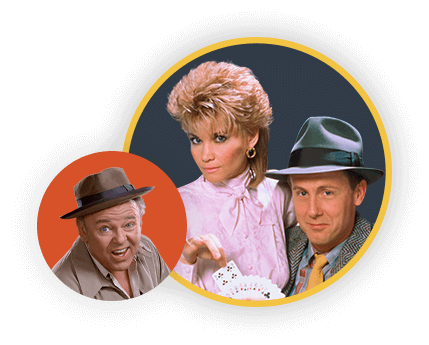11 top secret facts about 'The Man from U.N.C.L.E.'

Image: The Everett Collection{seealso}
In the wake of James Bond, the spy genre was booming on television in the 1960s. Mission: Impossible, Get Smart, The Man Who Never Was, I Spy and The Avengers were all fighting the Cold War with gadgets and secret-agent skills. And, of course, there was The Man from U.N.C.L.E..
When The Man from U.N.C.L.E. premiered in 1964, it was the only spy show on American television. As Napoleon Solo and Illya Kuryakin, Rober Vaughn and David McCallum were playing spy in a landscape full of sitcoms. The success of the show led to a sea change in programming.
Over the course of its four seasons, The Man from U.N.C.L.E. underwent drastic changes as well — as we'll detail below — making it arguably the definitive action series of the decade.
Here are 11 facts that make The Man from U.N.C.L.E. the coolest spy show of the 1960s — even when it became the silliest.

Like James Bond, Napoleon Solo and April Dancer were the brainchildren of Ian Fleming.
The show's creator, Norman Felton, enlisted erstwhile Navel Intelligence officer and novelist Fleming to come up with characters and premises for The Man from U.N.C.L.E. The Bond author dreamt up Napoleon Solo and April Dancer (The Girl from U.N.C.L.E.). The working title for the series was Ian Fleming's Solo.
Image: AP Photo

It is technically set in the Sherlock Holmes universe.
On the show, the U.N.C.L.E. organization's nemesis, T.H.R.U.S.H., was founded by the Sherlock Holmes villain Col. Sebastian Moran. In the backstory, Moran created the evil organization after his boss, Moriarity, went over the Reichenbach Falls. So, in a way, The Man from U.N.C.L.E. is a sequel to Sherlock — it is set in the same world. The modern Sherlock Holmes films and the recent Man from U.N.C.L.E. flick were all directed by Guy Ritchie, who has quietly developed his own cinematic shared universe.
Image: AP Photo

William Shatner and Leonard Nimoy appeared in an episode together — years before 'Star Trek.'
In "The Project Strigus Affair," the ninth episode, the soon-to-be Kirk and Spock were on opposite sides. Shatner played a good guy, while Nimoy was a henchman. They appeared in one scene together, two years before the voyages of the Enterprise began. James Doohan also popped up on the show. And Sonny & Cher, for what it's worth.

It was three dramatically (and comedically) different shows rolled into one.
The first season was filmed in black & white. Befitting that shadowy look, it took a more serious tone. In 1965, Napoleon Solo, like Dorothy, leapt into a world of bright color. In its four year run, the series had different showrunners each season, and each boss brought a different style to a table. The show went from noir spy thriller to bright and light adventures to outright spoof. By the end, it was emulating the mod, camp vibe of the hugely popular Batman.
Image: The Everett Collection

The United Nations forced the writers to come up with an acronym for "U.N.C.L.E."
Initially, the creators hoped to leave the meaning of "U.N.C.L.E." undefined for added mystery. However, considering the fictional secret agency operated out of the east side of New York City, the real United Nations was worried that people might assume the "U.N." stood for, well, the U.N. So the writers came up with "United Network Command for Law and Enforcement."

The meaning of "T.H.R.U.S.H." only appeared in a novel.
Meanwhile, the acronym for the nefarious T.H.R.U.S.H. is never mentioned on the show. However, the extended universe got around to defining it. It was explained to be Technological Hierarchy for the Removal of Undesirables and the Subjugation of Humanity in one of the tie-in books, The Dagger Affair.

A famous board game inventor designed the weaponry.
Reuben Klamer invented the classic Milton Bradley board game The Game of Life — you know, the one with little pink and blue pegs cruising around in a tiny convertible. He went from designing little wheels of fortune to deadly weaponry. Klamer designed "The Gun," Solo's nifty semi-automatic piece that could transform from a pistol into a rifle. Naturally, a toy version was sold.
Image: vintagetoyarchive / Tumblr

There is only one episode that does not have a "The _______ Affair" title.
The season two opener was called "Alexander the Greater Affair." For whatever reason, this is was the only episode to not start with the definite article.
Image: The Everett Collection

Illya Kuryakin's name was inspired by a fictional prostitute.
The name Illya was taken from the lead character in Jules Dassin's 1960 film Never on Sunday. She was a carefree prostitue in Athens, Greece. Later that decade, the movie was turned into a Broadway musical, Illya Darling.
Image: Discogs.com

The show inspired many musicians.
In 1966, the act Angela and the Fans released a bubblegum crush pop song called "Love Ya Illya." Years later, the post-punk band Cleaners from Venus recorded "Ilya Kuryakin Looked at Me" in the 1980s. Ska legends the Specials had their instrumental "Napoleon Solo." A decade later, the trip-hop supergroup U.N.K.L.E. admitted their name came from the spy series.

The Girl from U.N.C.L.E.'s original name was Cookie Fortune.
Phew, thank goodness they changed their mind on that one. We can thank Ian Fleming for the much improved moniker April Dancer. She earned her own TV series for one season in 1966–67.
Image: Gold Key Comics




